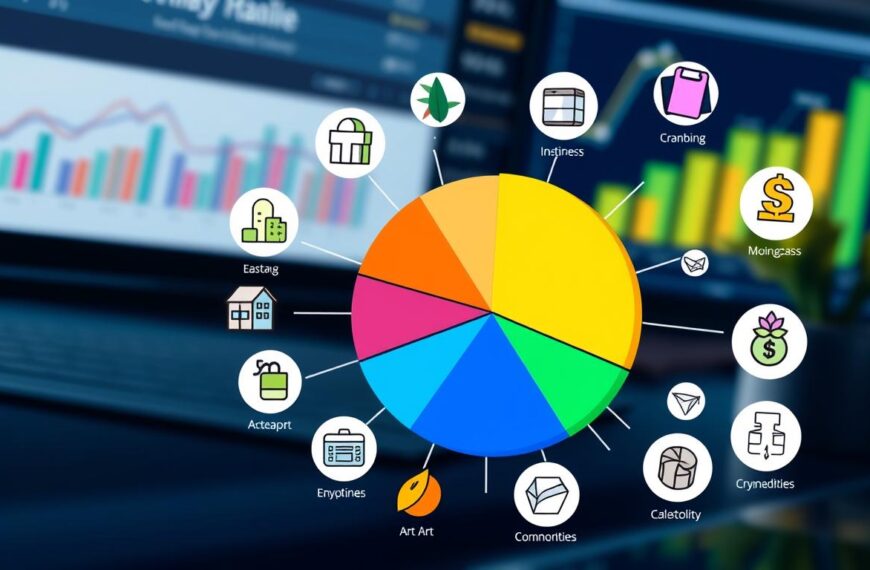Many people worry about their finances in retirement. With 55-year-olds now living up to 30 years longer, retirement planning is key. Inflation can reduce savings, so it’s vital to invest wisely for income and growth.
There are many ways to invest for retirement. You can choose from workplace pensions, personal pensions, and SIPPs. ISAs also offer tax benefits and diversification1.
Learning about retirement investing is the first step. Setting goals and thinking about how long you’ll live are also important. By looking at different pension schemes and investments, you can plan for a secure future2.
Understanding Retirement Investment Fundamentals
Getting ready for retirement means knowing how to invest. Inflation can eat away at your savings. Fidelity Investments says you should save a certain amount based on your age. For example, save one year’s salary by 30, three times your salary by 40, and so on3.
It’s also key to set realistic goals for retirement. The Retirement Living Standards suggest you need £14,400 a year for a basic life, £31,300 for more security, and £43,100 for comfort3. With people living longer, you’ll need enough savings for 38,000 hours of extra time in retirement4.
The Impact of Inflation on Retirement Savings
Inflation can make things cost more over time. For instance, £25,000 today could be over £40,000 in 25 years with 2% inflation4. Keeping your savings’ value is vital for a good retirement.
Setting Realistic Retirement Goals
Your retirement goals should match your life and what you want. The ‘4% to 5% annual withdrawal’ rule can help ensure a steady income in retirement. Remember to adjust for inflation each year4.
Life Expectancy Considerations
With people living longer, planning for a longer retirement is crucial. The average 65-year-old man lives 19 years, and women 21. So, you need enough savings for a long, comfortable retirement4.
Investing wisely means balancing risk and potential gains. Diversifying your investments and regularly reviewing your portfolio are key to reaching your retirement goals5.
| Retirement Savings Benchmark | Target by Age |
|---|---|
| 1 year’s salary | Age 30 |
| 3 times annual salary | Age 40 |
| 6 times annual salary | Age 50 |
| 8 times annual salary | Age 60 |
| 10 times annual salary | Age 67 |
“Maintaining the value of retirement savings is crucial to ensuring a comfortable lifestyle during the golden years.”
Common Workplace Pension Schemes
In the United Kingdom, most employees must have a workplace pension. There are two main types: defined benefit schemes and defined contribution schemes6.
Defined contribution schemes, or “money purchase” schemes, are the most common. Your retirement income depends on how much you contribute, for how long, and how well your investments do7. Some schemes might move your money to safer investments as you get closer to retirement7. You might also face fees from the scheme provider, based on your pension’s value7.
Defined benefit schemes, like final salary schemes, work differently. They base your retirement benefits on how long you’ve been in the scheme and your earnings7. You can get a tax-free lump sum, then regular income that’s taxed8. You’ll get annual statements from your provider, and can ask for estimates of your future pension7.
Employers must tell new employees about pension schemes within two months6. Most employers offer group personal pensions or stakeholder pensions. They usually contribute about 6% of your salary6.
| Pension Scheme Type | Key Features |
|---|---|
| Defined Benefit |
|
| Defined Contribution |
|
Workplace pension schemes are key for retirement savings. Knowing the differences between defined benefit and defined contribution schemes helps with pension planning768.

Personal Pension Plans and SIPPs
Personal pension plans and Self-Invested Personal Pensions (SIPPs) give you more control over your retirement savings. They are great for self-employed people and those wanting a customised plan9.
Benefits of Self-Invested Personal Pensions
A SIPP lets you invest in a variety of assets, like company shares and property. This can lead to better returns over time9. Plus, you get tax relief on contributions, up to 45% of your income9.
Tax Advantages and Contribution Limits
Personal pensions and SIPPs are tax-efficient, just like workplace schemes. The government adds 20p for every £1 you save9. You can contribute up to £60,000 a year, and carry forward unused allowances from the past three years10.
Investment Portfolio Management
SIPPs offer many investment choices, from funds to individual stocks. The cost of holding investments is capped at 0.4% of your pension’s value. There might be extra fees for buying and selling910. Choose a SIPP provider that fits your retirement goals and budget.
Getting advice from a financial advisor is wise when picking between personal pensions and SIPPs. They can help you understand the options and plan for your future.
Essential Retirement Investing Strategies
Creating a solid retirement investment plan is vital for your financial security. A key strategy is diversification – spreading your investments across different types. This helps manage risk. Allocate funds to low-risk options like bonds and cash for quick income, and to higher-risk investments like stocks for long-term growth11.
Keeping an emergency fund accessible is also crucial. It helps you avoid selling investments when the market is down.
It’s important to regularly review and adjust your investment portfolio as you get closer to retirement. This ensures your investments match your changing financial needs and long-term planning11. Saving at least 15% of your pre-tax income each year can also strengthen your retirement position11.
By balancing short-term needs with long-term goals, you can avoid over-spending. This helps prepare for a comfortable retirement.
| Retirement Investment Strategy | Key Considerations |
|---|---|
| Diversification | Spread investments across asset classes to manage risk |
| Emergency Fund | Maintain accessible savings to avoid selling during downturns |
| Regular Reviews | Rebalance portfolio as needs and goals evolve |
| Long-term Planning | Save at least 15% of pre-tax income annually |
“Investing for the long-term and regularly reviewing your portfolio is the key to a secure retirement.”
Alternative Investment Options for Retirement
When planning for retirement, think beyond the usual stocks, bonds, and cash12. Alternative investments can add variety to your portfolio12. These include real estate, commodities, and more12.
ISA Investment Opportunities
Consider the Individual Savings Account (ISA) for retirement savings13. You can save up to £20,000 a year tax-free13. Stocks and shares ISAs might offer higher returns but come with risks12. Cash ISAs and fixed-rate accounts are safer but may not beat inflation12.
High-Yield Investment Accounts
High-yield accounts can give you steady retirement income12. Real estate investments can bring in rental income and tax benefits12. Commodities can grow in value when inflation rises, keeping your money’s worth12.
Multi-Asset Fund Options
Think about multi-asset funds for a balanced investment14. These funds mix stocks, bonds, and alternatives14. They offer income and growth, spreading out your risk14. But remember, all investments have risks, and past success doesn’t mean future wins12. Get expert advice to fit your investment plan to your needs and comfort level.
FAQ
What are the best retirement investing options?
Investing for retirement is key to financial security. You can choose from workplace pensions, personal pensions, SIPPs, and ISAs. Each has its own benefits.
How does inflation impact retirement savings?
Inflation can lessen the value of your savings over time. It’s vital to manage your investments wisely. This includes thinking about both regular income and growth.
What are the typical retirement income requirements?
The Retirement Living Standards outline income needs. You’ll need £14,400 a year for basics, £31,300 for more security, and £43,100 for comfort.
How do workplace pension schemes work?
Workplace pensions are a must for most UK employees. There are two main types: defined benefit and defined contribution. Defined contribution schemes need a 5% employee contribution, with employers adding at least 3%.
What are the benefits of personal pensions and SIPPs?
Personal pensions and SIPPs give you more control over your investments. They’re great for the self-employed. SIPPs let you invest in a wide range, including company shares and property.
What are the key retirement investing strategies?
Good strategies include diversifying your investments to reduce risk. Keep an emergency fund handy. Regularly check and adjust your portfolio. Aim to save 15% of your pre-tax income each year.
What alternative investment options are available for retirement?
ISAs let you save tax-free up to £20,000 a year. Stocks and Shares ISAs can offer high returns but come with risks. Cash ISAs and fixed-rate accounts are safer. Multi-asset funds balance income and growth.

















